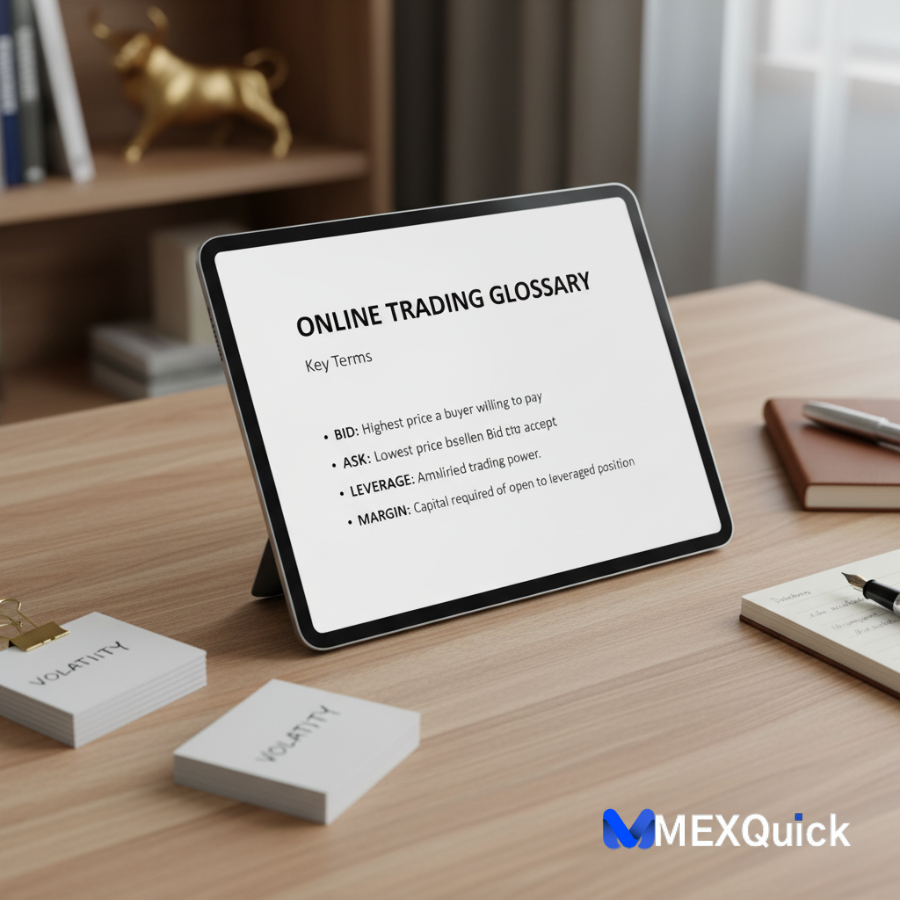
I remember staring at my first trading platform, feeling completely lost. The screen was a blur of unfamiliar words: “bid,” “ask,” “spread,” “margin.” I felt like everyone was speaking a secret language, and I was on the outside looking in. That confusion is a major barrier for most beginners.
Understanding trading terminology isn’t about showing off. It’s about survival. Misunderstanding a single term can lead to a costly mistake. This beginner trading glossary is your decoder ring. It will translate the jargon into plain English, giving you the confidence to navigate any platform, understand any analysis, and execute your strategy precisely.
Consider this your personal online trading dictionary. We’ll break down the essential online trading terms into logical categories, complete with clear examples. Bookmark this page. It will be your go-to reference until this language becomes second nature. Let’s build your vocabulary.
The Absolute Basics: Your First 10 Must-Know Terms
These are the foundational words you’ll encounter on every platform and in every discussion. Mastering this short list will immediately reduce your confusion.
- Asset: Anything you can buy or sell on a financial market. Examples: a stock (like Apple), a currency pair (like EUR/USD), a cryptocurrency (like Bitcoin), or a commodity (like Gold).
- Long (Going Long): The action of buying an asset with the expectation that its price will rise. If you “go long” on Tesla stock, you are buying it to sell later at a higher price.
- Short (Going Short): The action of selling an asset you don’t own (borrowed from your broker) with the expectation that its price will fall. You aim to buy it back later at a lower price, profiting from the difference. This is a core, yet often misunderstood, piece of trading terminology.
- Bull Market: A period of rising prices in a market, generally characterized by optimism and investor confidence.
- Bear Market: A period of falling prices in a market, generally characterized by pessimism and declining investor confidence.
- Order: An instruction you give to your broker to buy or sell an asset.
- Position: A trade that is currently active and not yet closed. Once you execute an order, you have an “open position.”
- Volatility: A measure of how rapidly and significantly an asset’s price can change. High volatility means large price swings; low volatility means smaller, more gradual changes.
- Liquidity: How easily an asset can be bought or sold in the market without affecting its price. Highly traded stocks like Amazon have high liquidity.
- Broker/Brokerage: The company (like Fidelity or Interactive Brokers) that provides you with a platform to access the financial markets and execute your trades.
Order Types: How You Talk to the Market

When you want to trade, you don’t just shout “Buy!”. You use a specific type of order. Understanding these online trading terms is critical for precise execution.
Core Order Types
- Market Order: An order to buy or sell an asset immediately at the best available current market price. It’s fast but you don’t control the exact price you get.
- Limit Order: An order to buy or sell an asset only at a specific price or better. It gives you price control but does not guarantee the order will be filled.
- Example: A “Buy Limit” order at $150 for Apple stock means you will only buy if the price drops to $150 or lower.
- Stop-Loss Order (or Stop Order): An order designed to limit your loss on a position. It becomes a market order to sell once the asset’s price reaches a specified level.
- Example: If you buy Apple at $160, you might place a “Sell Stop” order at $155. If the price falls to $155, it triggers a market order to sell, capping your loss.
- Take-Profit Order: An order to automatically close a position when it reaches a certain profit level. It locks in your gains.
The Mechanics of Price: Bid, Ask, and Spread
This is where many beginners get tripped up. Understanding this trio is non-negotiable for this online trading dictionary.
- Bid Price: The highest price a buyer is willing to pay for an asset at a given moment. If you want to sell immediately, you sell at the bid price.
- Ask Price (or Offer Price): The lowest price a seller is willing to accept for an asset. If you want to buy immediately, you buy at the ask price.
- Spread: The difference between the Bid and the Ask price. This is how many brokers and market makers make their money. A tighter (smaller) spread is generally better for traders.
Simple Analogy: Think of a used car lot. The dealer’s “Bid” is what they’ll pay for your car. The “Ask” is the price they’re selling it for. The “Spread” is their profit margin.
Risk and Analysis Terms: Protecting and Informing Your Trades
This beginner trading glossary wouldn’t be complete without the terms that help you manage risk and make decisions.
Risk Management Terminology
- Leverage: Using borrowed capital (from your broker) to increase your potential return. While it can amplify gains, it also dramatically amplifies losses, making it one of the riskiest concepts in trading terminology.
- Margin: The amount of your own capital that is required to open and maintain a leveraged position. It’s essentially your collateral.
- Margin Call: A demand from your broker to deposit more funds into your account to maintain your open positions. This happens when your losses threaten to exceed your deposited margin.
Analysis Terminology
- Fundamental Analysis (FA): Evaluating an asset by examining related economic, financial, and other qualitative and quantitative factors. For a stock, this means analyzing the company’s earnings, management, and industry.
- Technical Analysis (TA): Analyzing an asset by studying statistics generated by market activity, such as past prices and volume. Traders using TA rely on charts and indicators to predict future movements.
Conclusion: From Jargon to Juggernaut
Learning trading terminology is the first, crucial step in your journey from novice to knowledgeable trader. This online trading dictionary has given you the key to decode platform interfaces, understand market commentary, and communicate your ideas clearly.
Remember, this isn’t about memorizing a list for a test. It’s about building a functional vocabulary that will protect your capital and improve your decision-making. The confidence that comes from understanding these online trading terms is invaluable.
Your Action Plan to Master the Lingo:
- Open Your Demo Account: Log in to your brokerage’s demo platform and actively look for 5-10 terms from this list on the screen. See them in their natural habitat.
- Read One Market Analysis Article Daily: As you read, note any unfamiliar terms and look them up. Context is the best teacher.
- Use the Terms: When discussing trades or strategies, even in your own journal, make a conscious effort to use the correct terminology. This reinforces your learning.
Now I want to hear from you. What trading term confused you the most when you were starting out? Or, is there a term you’ve heard recently that you’d like me to explain? Drop your questions and experiences in the comments below—let’s build our knowledge together. If this guide was your decoder ring, please share it with another trader who might need it.
